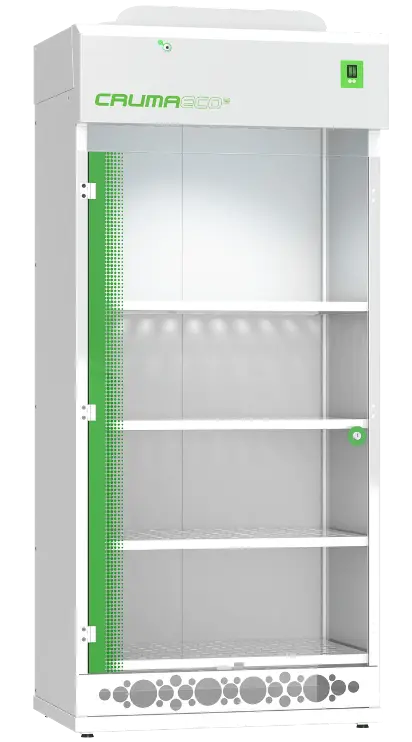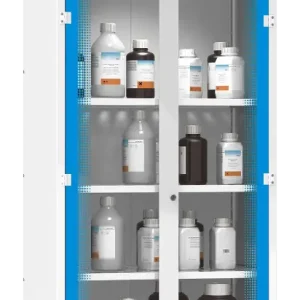CRUMA 2010 ECO
Login to see pricesStorage of chemical products, liquid or solid under the criteria of incompatibilities.
Filters available:
- TypeA:Suitable for organic vapours such as ketones, ethers, alcohols, aromatics compounds, etc.
- TypeBE:For inorganic acid vapours such as H2SO4, HCl, HNO3 and volatile sulfur compounds such as H2S, SO3, etc.
- TypeF:For formaldehyde vapours, formol, and derivatives.
- TypeK:Suitable for ammoniacal vapours (NH3) and amines.
- TypeD:HEPA H-14 filter, suitable for the filtration of dust
Description
The ECO2 storage cabinet is a more simplified and environmentally friendly product without sacrificing performance, functionality and quality. In response to a demanding market, our R+D+i department has developed this new model based on two fundamental premises: Economy and Ecology, hence its name. All of this while maintaining the technology used in our ductless fumehoods, which allows the vapors generated inside to be adsorbed and does not require a connection to the outside. In this way, it allows liquid or solid reagents to be stored inside and prevents both dust and toxic, inflammable or corrosive vapors from accumulating inside or being expelled into the working room.
Certified: Manufactured in Barcelona and certified by an external laboratory following international standars, applying the criteria of ISO 9001:2015.
Mobility and Flexibility: Due to its dimensions and reduced weight, as well as the absence of works to install a duct system outside, the possibilities of location and replacement are simpler. Moreover, as it is a dismountable product, it can be stored and placed in any laboratory without any problem (narrow passages, narrow or difficult to access stairs, etc.).
Protection: Thanks to its filtration system, the aspirated air is recirculated back into the room free of contaminants, thus allowing a constant renewal of the room air. Toxic vapors and contaminating particles are captured inside the filter, where they are neutralised.
Green and Sustainable: In addition, not consuming the laboratory’s air conditioning, it substantially reduces energy costs while providing point-of-use protection without releasing hazardous pollutants into the atmosphere.
Technical Data
| Internal Sizes (Width/Depth/High) | 760x468x1393 |
| External Sizes (Width/Depth/High) | 800x500x1834 |
| Filtering columns | 1 |
| Filter number | 1 a 2 |
| Number of IP44 fans | 1 |
| Internal volume of the cabinet | 0.567m3 |
| Total electrical power consumption | 47 W |
| Voltage-Frequency | 110-220 V / 50-60 Hz |
| LED light intensity | 1500 lx / LED 16 W |
| Storage capacity (litres) | 80 l. max. (20 l. per shelf) |
| Noise level | 55 dB |
| Weight | 150 Kg |
| Packaging volume | 1.1 m3 |



